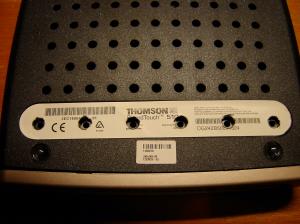
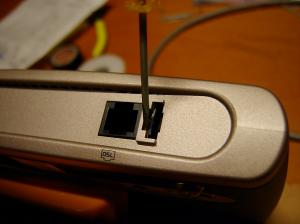
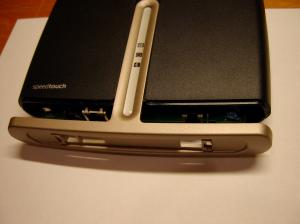
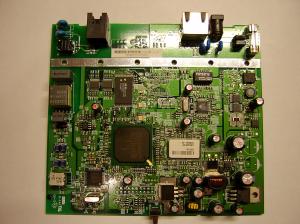
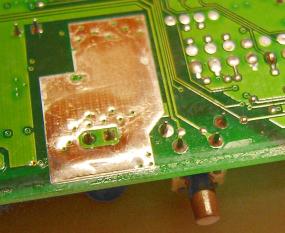
The last picture shows the reset button, bottom PCB view. Voltage across reset button: 3.222V, short circuit current is 0.3mA. One lead has about 0.001V and the other lead 3.224V. The latter is connected to both pin 4 (1!SD) and pin 14 (Vcc) of a 74LVC74A flip-flop. These leads need to be connected to (for example) a TIL111 opto-coupler. It is best to put the optocoupler inside the modem as well:
Circuit which connects the TIL111 opto-coupler to a serial port:
#!/usr/bin/env python
# power on/off an Alcatel Speedtouch 510 modem using some circuitry
# controlled via RTS/DTR
from os import open, O_RDONLY
from sys import argv, stderr, exit
from termios import TIOCMBIS, TIOCMBIC, TIOCM_RTS, TIOCM_DTR
from fcntl import ioctl
from select import select
from struct import pack
from time import sleep
if argv[1:] == ['on']:
time = 0.02 # >=0.01
elif argv[1:] == ['off']:
time = 5.0 # >=4.0
else:
print >>stderr, "Usage: st510 on|off"
exit(1)
rts = pack('I', TIOCM_RTS)
dtr = pack('I', TIOCM_DTR)
fd = open('/dev/ttyS2', O_RDONLY)
# opening a serial line will assert RTS and DTR but we should not rely on that.
ioctl(fd, TIOCMBIS, rts)
# Charge up the capacitor. This mechanism avoids random resets when
# pulling plugs or powering the system on- and off.
#
# 50 pulses -
# 250 pulses 10 sec reset possible starting at 3mA
# 500 pulses 15 sec reset possible starting at 4mA
# 1000 pulses - 10.5V 18 sec reset possible starting ar 5mA
#
# 250 pulses will do, 500 works but to stay on the safe side...
for i in range(1000):
ioctl(fd, TIOCMBIC, dtr)
select([], [], [], 0.001)
ioctl(fd, TIOCMBIS, dtr)
select([], [], [], 0.001)
# Capacitor charged up, DTR is set. fire by clearing RTS
ioctl(fd, TIOCMBIC, rts)
select([], [], [], time)
ioctl(fd, TIOCMBIS, rts)
# if we close fd within 25 seconds then the remaining capacitor charge may generate
# another reset pulse when RTS goes down.
# This could switch the modem back on when we are supposed to switch it off. The other
# way around it gets even worse: when the reset is pressed a number of times while
# the modem has just been switched on it will reload the factory settings (consult the
# manual about the exact reset sequence for this). So, we're anal and wait a full minute.
sleep(60)
#!/bin/sh # Determine if our Alcatel speedtouch ADSL modem may need a reset. ret=1 for ip in `sed -n 's/^nameserver//p' /etc/resolv.conf` do # TTL 1 is eaten by the modem # TTL 2 is eaten by its ATM peer which may be affected by a modem reset. # try 3,4,5 x=`traceroute -n -m 5 -f 3 $ip 2>/dev/null | grep -v '\* \* \*'` if [ -n "$x" ] then ret=0 break fi done exit $ret
(note: I have an "internet" startup script which issues an "st510 on" upon powerup)
#!/bin/sh st510-status && exit # try to switch it on -- shouldn't be necessary as /etc/rc.d/init.d/internet # does this as well at startup (e.g. when power has been restored). echo "Powering on st510" st510 on sleep 100 st510-status && exit echo "st510 not ok" # the hard way echo "Powering off st510" st510 off echo "Powering on st510" st510 on # nothing else we can do -- we'll come back in an hour